Classic & Sports Car August 2021 Big Cat Rescue
Reproduced with permission of Classic & Sports Car magazine (August 2021)
Now 25 years old, Jaguar’s X100 has finally realised its classic potential, as the XK8 and XKR show alongside the one that got away.
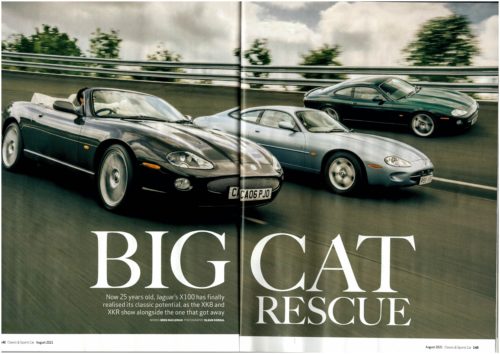
Classic and Sports Car August 2021
Big Cat Rescue
Page 142-143
Somehow, somewhere – probably deep in a dark attic at Jaguar’s Gaydon headquarters or maybe Geoff Lawson’s loft – there must be hanging a slowly deteriorating portrait of the XK8. It’s the only possible way to make sense of how Jaguar’s seemingly timeless grand tourer has remained such an object of desire for more than a quarter of a century.
The decades defying shape is even more remarkable when you consider that the styling, forged not long after the otherworldly XJ220 yet taking inspiration from 30 years earlier, had barely changed in the 10 years it remained on sale.
The X100’s looks have aged beautifully, but what about the dynamics/ To celebrate the model’s 25th birthday, we arranged a special party at Jaguar Classic’s Fen End test facility – historic site of disc-brake development and later Prodrive’s Subaru World Rally cars – and extended an invitation to three significant guests: an early XK8 coupé from the first year of production, a hot run-out XKR variant in convertible trim and, most exciting of all, Special Vehicle Operations’ bonkers XKR-R prototype – a tantalising vision of what might have been.
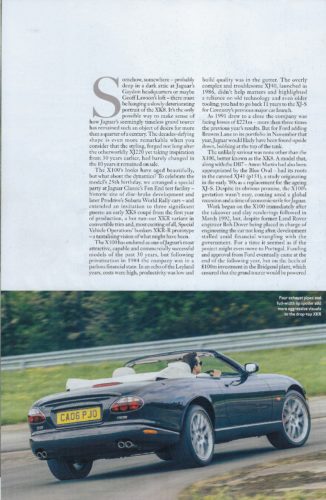
Classic and Sports Car August 2021
Big Cat Rescue
Page 144
The X100 has endured as one of Jaguar’s most attractive, capable and commercially successful models of the past 30 years, but following privatisation in 1984 the company was in a parlous financial state. In an echo of the Leyland years, cost were high, productivity was low and build quality was in the gutter. Th overly complex and troublesome XJ40, launched in 1986, didn’t help matters and highlighted a reliance on old technology and even older tooling, you had to go back 11 years to the XJ-S for Coventry’s previous major car launch.
As 1991 drew to a close the company was facing losses of £221m – more than three tomes the previous year’s results. But for Ford adding Browns Lane to its portfolio in November that year, Jaguar would likely have been found upside down, bobbing at the top of the tank.
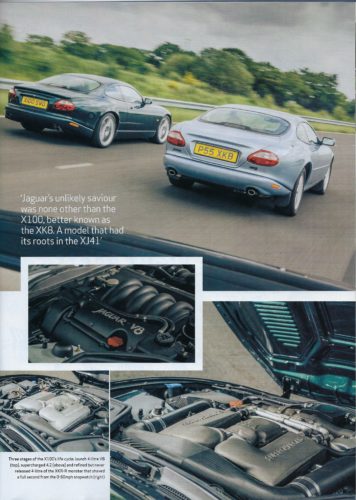
Classic and Sports Car August 2021
Big Cat Rescue
Page 145
Jaguar X100
The unlikely saviour was none other than the X100, better known as the XK8. a model that, along with the DB7 – Aston Martin had also been appropriated by the Blue Oval – had its roots in the canned XJ41 (p151), a study originating in the early ’80s as a replacement for the ageing XJ-S.
Despite its obvious promise, the X100’s gestation wasn’t easy, coming amid a global recession and a time of economic strife for Jaguar.
Work began on the X100 immediately after the takeover and clay renderings followed in March 1992, but, despite former Land Rover engineer Bob Dover being placed in charge of engineering the car not long after, development stalled amid financial wrangling with the government. For a time it seemed as if the project might even move to Portugal. Funding and approval from Ford eventually came at the end of the following year, hot on the heels of £100m investment in the Bridgend plant, which ensured that the grand tourer would be powered not by an engine parachuted in from North America, but by the all-new 4-litre AJ-V8 unit of Jaguar’s own design.
That was, it must be said, a rather good decision. Instead of soldiering on with old technology, the coupé got a gem of an engine with four camshafts and four valves per cylinder. Good for 290 bhp in normally aspirated guise and with 290 lb ft of torque, the XK8 is quick enough to trouble 60 mph inside 6.5 seconds and has to be electronically reined in as it reaches 155 mph. But, despite the impressive power figures, there’s something stately about the early car that makes driving it more about the experience than the performance.
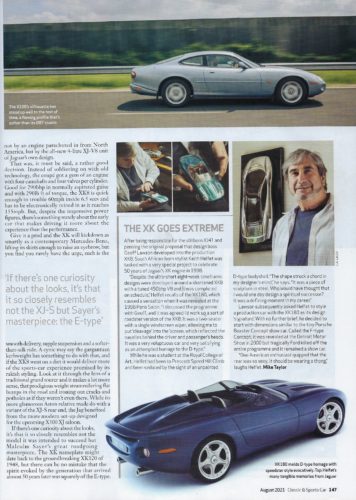
Classic and Sports Car August 2021
Big Cat Rescue
Page 147
Give it a prod and the XK will kickdown as smartly as a contemporary Mercedes-Benz, lifting its skirts enough to raise an eyebrow, but you find you rarely have the urge, such is the smooth delivery, supple suspension and a softer-than-silk ride. A cynic may say the gargantuan kerbweight has something to do with that, and if the XK8 went on a diet it would deliver more of the sports-car experience promised by its rakish styling.
Look at it through the lens of a traditional grand tourer and it makes a lot more sense, that prodigious weight steamrollering flat humps in the road and ironing out cracks and potholes as if they weren’t even there. While its more glamourous Aston relative made do with a variant of the XJ-S rear end, the Jag benefited from the more modern set-up designed for the upcoming X300 XJ saloon.
If there’s one curiosity about the looks, it’s that it so closely resembles not the model it was intended to succeed but Malcolm Sayer’s great roadgoing masterpiece. The XK nameplate might date back to the groundbreaking XK120 of 1948, but there can be no mistake that the spirit evoked by the generation that arrived almost 50 years later was squarely of the E-type.
The E-type burst onto the scene as a vision of swooping lines and sumptuous curves against a backdrop of decidedly old-fashioned designs, and the XK8 draws admiring glances for all the same reasons. In a world of bland and homogenous Japanese imports, plastic-bumpered shopping cars and even its slab-sided BMW 8 Series rival, the sleek XK cuts a particular dash, an organic and aerodynamic sloop that screams sexy – or at least a middle-aged golfer’s idea of it.
Geoff Lawson’s sublime design undoubtedly forged its own identity, but the ancestry is clear to see from the fish-mouthed front grille to the rounded flanks, with wheels set back behind generous overhangs.
Jaguar XKR
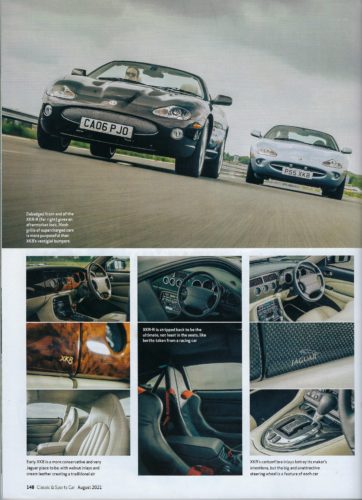
Classic and Sports Car August 2021
Big Cat Rescue
Page 148
A full decade separate the first XK8s to leave Browns Lane and the last-of-the-line XKR convertible that we’ve taken to Fen End, and it’s hard not to be struck by quite how similar the two cars are – bar the obvious roof chop. The overall shape barely changed, the only major facelift arriving in 2002. That brought with it a lightly restyled front bumper, jazzy jewelled rear lights with chrome finishing and forward-facing Xenons, not to mention the revised ‘growler’ badging and an array of huge alloy wheels.
Bigger changes went on beneath the bodywork, and though a raft of electronic safety equipment ranging from Electronic Stability Control to Emergency Brake Assist was added, along with much more comfortable front seats, it’s the engine that puts clean air between the two iterations. Across the board the old 3,996 cc V8 was updated with an increase in capacity of 200 cc. That might not sound like a lot- combined with continually variable camshaft phasing, power was only increased by 3.5% in the XK8 and up to 8.1%, to 400 bhp, in the hotter XKR – but boy does it feel like more. In real terms the update added a hefty dose of usable torque to both models, adding lead to the glove and resulting in a heavier punch as you plant the throttle. With the roof off you not only feel the thump of acceleration but hear it too, with a shrill Eaton supercharger whine almost totally drowning out the V8 and it quad-pipe roar.
Inside, the bijou cabin of the earlier car is till intact and just as cossetting, but some of the classiness is undoubtedly lost with the addition of carbonfibre where once there was walnut. The updated and supportive seats are great, and fortunately the optional infotainment system hasn’t been added. It always looked somewhat anachronistic dropped into the middle of the dash in place of the classic round analogue dials. Look down at the centre console and the familiar Jaguar J-gate remains, albeit now controlling a six-speed ZF gearbox – the first auto with half a dozen cogs outside of stepped CVTs. Not only does it give the big cat longer legs, but it also irons out an irritating driveline thump when taking up drive from a near stop.
Jaguar XKR-R
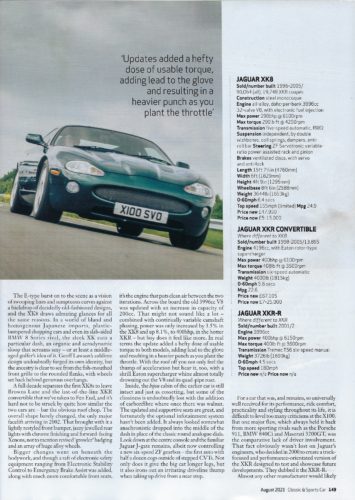
Classic and Sports Car August 2021
Big Cat Rescue
Page 148
For a car that was, and remains, so universally well received for its performance, ride comfort, practicality and styling throughout its life, it is difficult to level too many criticisms at the X100. But one major flaw, which always held it back from more sporting rivals such as Porsche 911, BMW 840Ci and Maserati 3200GT, was the comparative lack of driver involvement. The fact obviously wasn’t lost on Jaguar’s engineers, who decided in 2000 to create a track-focused and performance-orientated version of the XKR designed to test and showcase future developments. Thy dubbed it the XKR-R.
Almost any other manufacturer would likely have crushed such a prototype along with any dreams of what might have been, consigning it to little more than a footnote in stories about its tamer cousins. Jaguar, thankfully, had different ideas, entrusting its track-ready wild child – officially the X100 SVO – to the Jaguar Daimler Heritage Trust, based at the British Motor Museum, Gaydon. Now, it is on day release.
Starting with a pre-facelift XKR as its base, Special Vehicle Operations – then more of a skunkworks than the specialist division that exists today – fully seam-welded its coupé monocoque for greater strength and rigidity, already up 25% on the XJ-S in standard guise. A partial rollcage was added along with kidney-squeezing Recaro bucket seats and four-point harnesses, and the rear seats were replaced by bins to accommodate two crash helmets – a hint at where Jag boffins foresaw the car being used.
The engine was lifted straight from the first-generation 4-litre XKR, but with power up from 370 to 400 bhp thanks to some light fettling at SVO. There are bigger changes at the back, where the rear end of the donor XKR was thrown out entirely and replaced by a derivative of the S-type’s suspension set-up. It’s got stance, too, sitting 30 mm lower on huge 20 in BBS alloys shod with Pirelli P Zero tyres – an aggressive squat that suits the car perfectly.
But what really sets this car apart is the six-speed Tremec T56 gearbox, a meaty manual that found a home in everything from Yanks such as the Corvette and Viper to blue-bloods including the Vanquish.
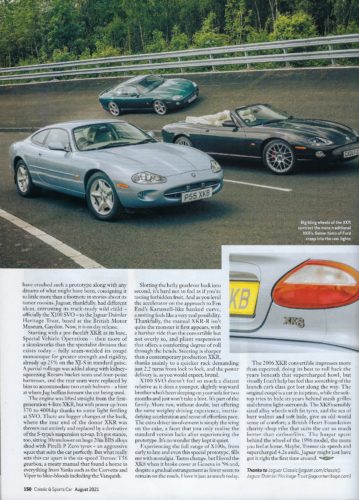
Classic and Sports Car August 2021
Big Cat Rescue
Page 150
Slotting the hefty gearlever back into second, it’s hard not to feel as if you’re tasting forbidden fruit. And as you level the accelerator on the approach to Fen End’s Karussell-like banked curve, a smiting feels likes a very real possibility. Thankfully, the manual XKR-R isn’t quite the monster it first appears, with a harsher ride than the convertible but not overly so, and pliant suspension that offers a comforting degree of roll through the bends. Steering is sharper than a contemporary production XKR, thanks mainly to a quicker rack demanding just 2.2 turns from lock to lock, and the power delivery is, as you would expect, brutal.
X100 SVO doesn’t feel so much a distant relative as it does a younger, slightly wayward brother who’s been sleeping on your sofa for two months and just won’t take a hint. It’s part of the family. More raw, without doubt, but offering the same weighty driving experience, inertia-defying acceleration and sense of effortless pace. The extra driver involvement is simply the icing on the cake, a facet that you only realise the standard version lacks after experiencing the prototype. It’s no wonder they kept it quiet.
Experiencing the full range of X100, from early to late and even this special prototype, fills me with nostalgia. Tastes change, but I loved the XK8 when it broke cover at Geneva in ’96 and. despite a gradual estrangement as fewer seem to remain on the roads. I love it just as much today.
The 2006 XKR convertible impresses more than expected, doing its best to roll back the years beneath that supercharged howl, but visually I can’t help but feel that something of the launch car’s class got lost along the way. The original coupé is a car in its prime, while the soft-top tries to hide its years behind mesh grilles, and chrome light-surrounds. The XK8’s sensibly sized alloy wheels with fat tyres and the sea of burr walnut and soft hide, give an old-world sense of comfort; a British Heart Foundation charity-shop vibe that suits the cars so much better than carbonfibre. The longer spent behind the wheel of the 1996 model, the more you feel at home.
Maybe, Tremec six-speeds and supercharged 4.2s aside, Jaguar might just have got it right the first time around.
The XK Goes Extreme – XK180
Mike Taylor talks to Keith Helfet
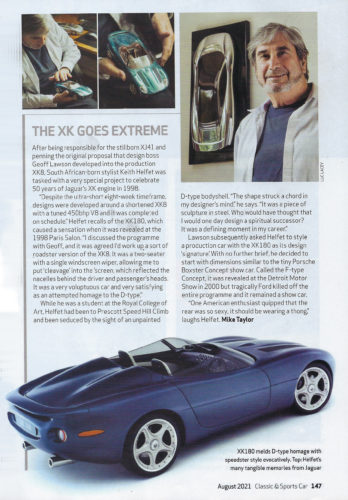
Classic and Sports Car August 2021
Mike Taylor talks to Keith Helfet
Page 147
After being responsible for the stillborn XJ41 and penning the original proposal that design boss Geoff Lawson developed into the production XK8, South African-born stylist Keith Helfet was tasked with a very special project to celebrate 50 years of Jaguar’s XK engine in 1998.
“Despite the ultra-short eight-week timeframe, designs were developed around a shortened XK8 with a tuned 450 bhp V8 and it was completed on schedule.” Helfet recalls of the XK180, which caused a sensation when it was revealed at the 1998 Paris Salon. “I discussed the programme with Geoff, and it was agreed I’d work up a sort of roadster version of the XK8. It was a two-seater with a single windscreen wiper, allowing me to put ‘cleavage’ into the screen, which reflected the nacelles behind the driver and passenger’s heads. It was a very voluptuous car and very satisfying as an attempted homage to the D-type.”
While he was a student at the Royal College of Art, Helfet had been to Prescott Speed Hill Climb and been seduced by the sight of an unpainted D-type bodyshell. “The shape struck a chord in my designer’s mind,” he says. “It was a piece of sculpture in steel. Who would have thought that I would one day design a spiritual successor? It was a defining moment in my career.”
Lawson subsequently asked Helfet to style a production car with the XK180 as its design ‘signature’. With no further brief , he decided to start with dimensions similar to the tiny Porsche Boxster Concept show car. Called the F-type Concept, it was revealed at the Detroit Motor Show in 2000 but tragically Ford killed off the entire programme and it remains a show car.
“One American enthusiast quipped the rear was so sexy, it should be wearing a thong”, laughs Helfet.
XK8 Specifications
| JAGUAR XK8 | JAGUAR XKR CONVERTIBLE | JAGUAR XKR-R | |
| SOLD / NUMBER BUILT | 1996-2005 90,064 (all) 19,748 coupés |
1998-2005
13,895 |
2001
2 |
| CONSTRUCTION | Steel monocoque | Steel monocoque | Steel monocoque seam welded |
| ENGINE | All-alloy DOHC-per-bank 3,996 cc 32-valve V8 Electronic fuel injection |
All-alloy DOHC-per-bank 4,196 cc 32-valve V8 Electronic fuel injection With Eaton rotor-type supercharger |
All-alloy DOHC-per-bank 3,996 cc 32-valve V8 Electronic fuel injection With Eaton rotor-type supercharger |
| POWER | 290 bhp @ 6,100 rpm | 400 bhp @ 6,100 rpm | 400 bhp @ 6,150 rpm |
| TORQUE | 290 lb ft @ 4,250 rpm | 408 lb ft @ 3,500 rpm | 400 lb ft @ 3,600 rpm |
| TRANSMISSION | Five speed automatic RWD | Six speed automatic RWD | Tremec T56 Six speed manual, RWD |
| STEERING | ZF servotonic variable-ratio power assisted rack and pinion | ZF servotonic variable-ratio power assisted rack and pinion | ZF servotonic variable-ratio power assisted rack and pinion |
| SUSPENSION Front: | Independent, by double wishbones, coil springs, dampers, anti-roll bar | Independent, by double wishbones, coil springs, dampers, anti-roll bar | Independent, by double wishbones, coil springs, dampers, anti-roll bar |
| BRAKES | Ventilated discs , with servo and anti-lock | Ventilated discs , with servo and anti-lock | Ventilated discs , with servo and anti-lock |
| LENGTH | 15ft 7 ½ in 4,760 mm |
15ft 7 ½ in 4,760 mm |
15ft 7 ½ in 4,760 mm |
| WIDTH | 6ft 1,829 mm |
6ft 1,829 mm |
6ft 1,829 mm |
| HEIGHT | 4ft 9in 1,295 mm |
4ft 9in 1,295 mm |
4ft 9in 1,295 mm |
| WEIGHT | 3,644 lb 1,653 kg |
4,000 lb 1,815 kg |
3,726 lb 1,690 kg |
| PERFORMANCE | Top speed 155 mph (limited) 0-60 mph 6.4 secs |
Top speed 155 mph (limited) 0-60 mph 5.6 secs |
Top speed 180 mph (limited) 0-60 mph 4.5 secs |
| FUEL CONSUMPTION | 24.9 mpg | 22.6 mpg | Not recorded |
Thanks to Jaguar Classic (jaguar.com/classic) and Jaguar Daimler Heritage Trust (jaguarheritage.com)
Words: Greg MacLeman
Photography: Olgun Kordal